Fujica didn’t make a lot of interchangeable mount 35mm SLRs, but they did make some interesting ones.
From 1970, with the introduction of the ST701, they produced a series of models in a variant of m42 mount. the 701 (introduced first) was an enthusiast manual exposure model, the 801 was the top-flight manual exposure model with open aperture metering and the 601 was a budget model. In addition, there was a 901 which also offered aperture priority auto exposure with LED numeric readouts in the viewfinder. The 701 and 601 also got updates as the 705 and 605.
Over time the higher end models got cosmetic updates, while the lower-end models got extra features added. In its ‘605 II’ variant, even the budget model gained open aperture metering. But in general there were no big re-thinks or changes of direction. The batteries stayed in the same, unconventional position, as did the tripod mount and rewind buttons.
The whole range of Fujica ST models spanned just 9 cameras in 8 years. Fujica started off with a decent formula for their 35mm SLRs and they stuck with it.
Fujica’s implementation of open aperture m42 was interesting and quite elegant. It combined the screw mount with a shallow pin that locked the lens in place on the final turn of mounting the m42 lens – giving a lens that is always precisely oriented (if it is a Fujinon). The aperture ring also adopted a small ‘tab’ that enables the camera to read the position of the aperture ring.
The Fujica AZ-1
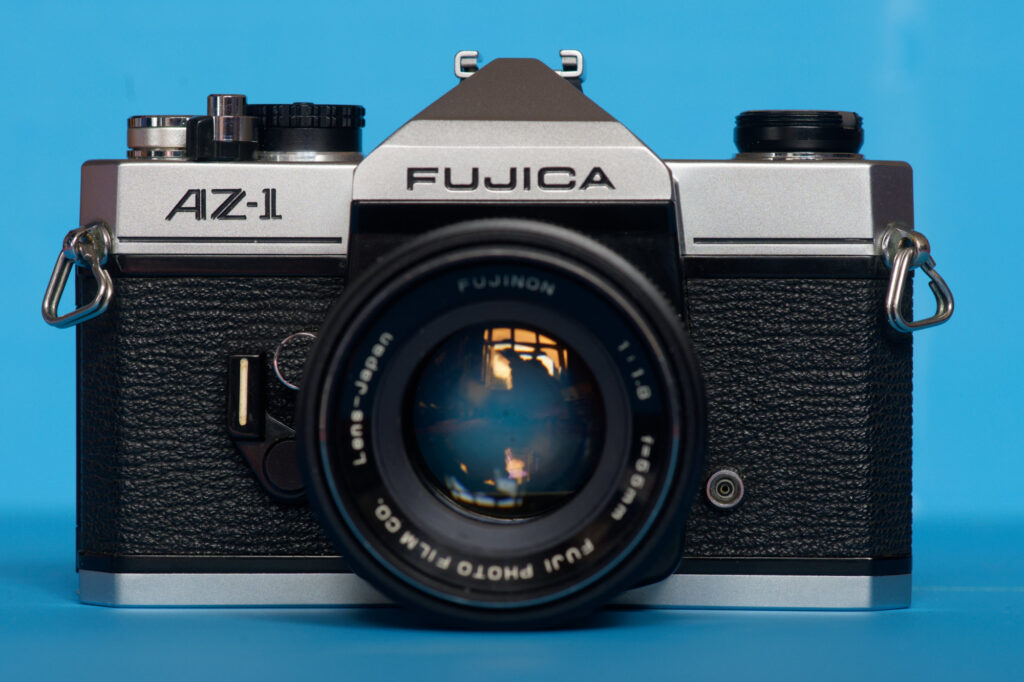
In an odd (and half-hearted) rebranding before switching to a bayonet mount, Fujica abandoned the ‘ST’ series numbers for the release of the Fujica AZ-1 in 1978. Around this time, Fujica also released two late variants of other cameras in the range. One of these was the ST705W (same as the ST705 but able to take a winder) and the ST605 II (same as the ST605n but with open aperture metering). The AZ-1 was a variant on the ST901 formula. It abandoned the viewfinder blind and numeric exposure readouts in the viewfinder of the ST901 in favour of a more conventional strip of LED lights and connections for an autowinder (which could also be used on the ST701w). They also made the camera a bit ‘prettier’ – copying the more elegant look of the ST705/605 cameras.
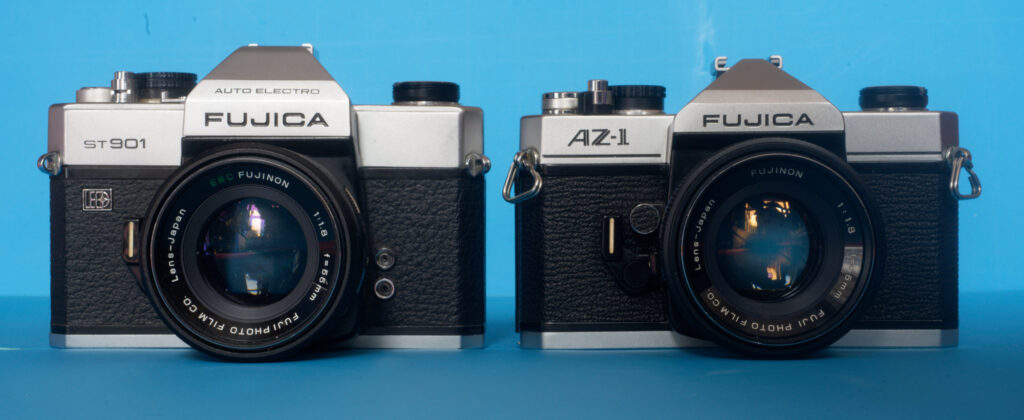
Quirks and oddities
Like the earlier Fujica SLRs, the Fujica AZ-1 camera uses super-fast silicon photodiodes. this is great, but the AZ-1 combines them with a meter that comes on – and then instantly locks – on a half press of the shutter release. The metered speed will stick until you lift your finger and re-press. It is a fully electronic implementation of a trap-needle auto-exposure system. This suits my shooting style and preferences, but it is not really playing to the innate strengths of the silicon photodiodes.
In addition to the exposure lock, the shutter speed dial includes compensation marks for up to two stops (a-la OM-2), which means you have to be careful not to compensate twice..
Fujica designed the AZ-1 to take an autowinder – but because of the exposure lock on the shutter release, all shots will use the same exposure until you lift your finger off the shutter release. Not metering dynamically with an autowinder is not too much of a worry these days. If you are into continuous shooting, you are probably going to be doing it with digital rather than relatively expensive film, but it was probably more of an issue in 1978.
On a more positive note, the Fujica AZ-1 takes readily available 1.55v silver-oxide batteries. In a slight departure, it takes three.
There is no manual metering. Switch away from the AE settings and the LEDs in the viewfinder go blank (I understand this is similar to the ST901, but the only example of a 901 I have access to has a dead meter, so I can’t confirm).
The shutter speed dial on the top-plate of the Fujica AZ-1 does not offer a full range of manual speeds. The available speeds are spaced out every two stops – 1/1000, 1/250, 1/60 (the synch for flash) and then B. On the plus side, these are mechanical shutter speeds, and will still fire even if the batteries are exhausted or absent. To give some context, auto-only SLRs had been pioneered by Pentax with the ME, which only had one mechanical speed (for flash synch). Following this lead, pretty much all of the manufacturers (including Nikon) produced their own budget auto-only SLRs. The difference was that the AZ-1 was a fairly high-end camera. There is room on the dial. Did they think it would be difficult to make it clear what speeds would work without batteries? We will probably never know, but I’m guessing that no-one was entirely happy with the eventual decision.
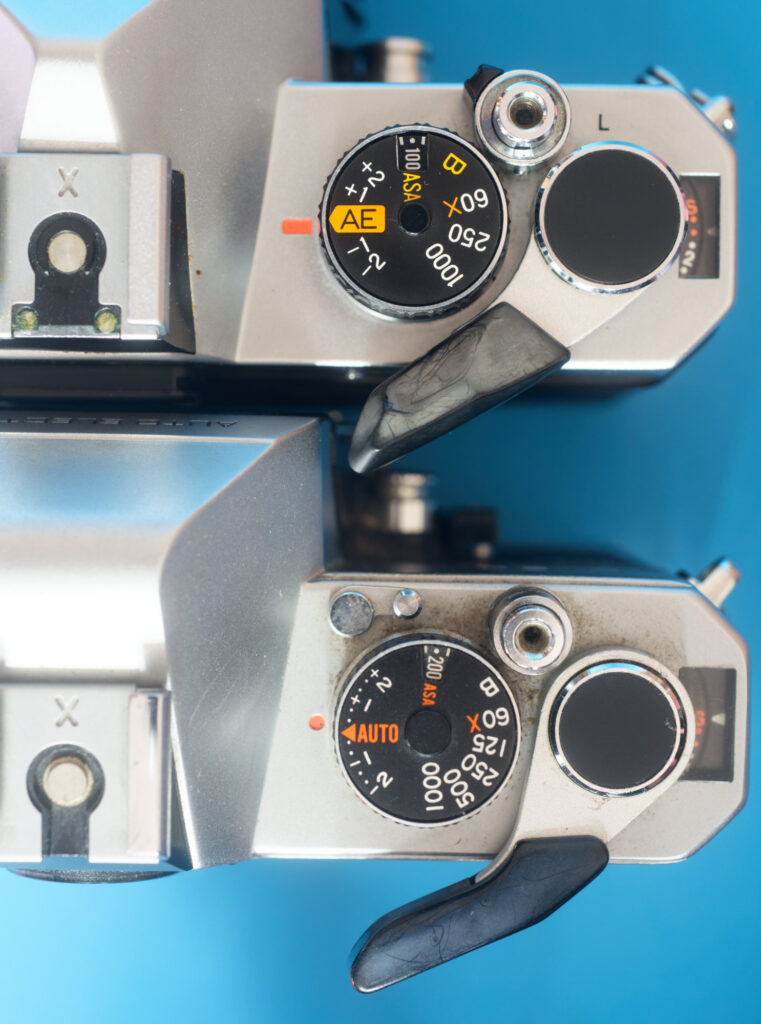
The ST901 speed dial (bottom) compared to the one for the AZ-1 (top). Note the redesigned articulated wind-on tip and the lack of a dial lock on the Fujica AZ-1
Controls
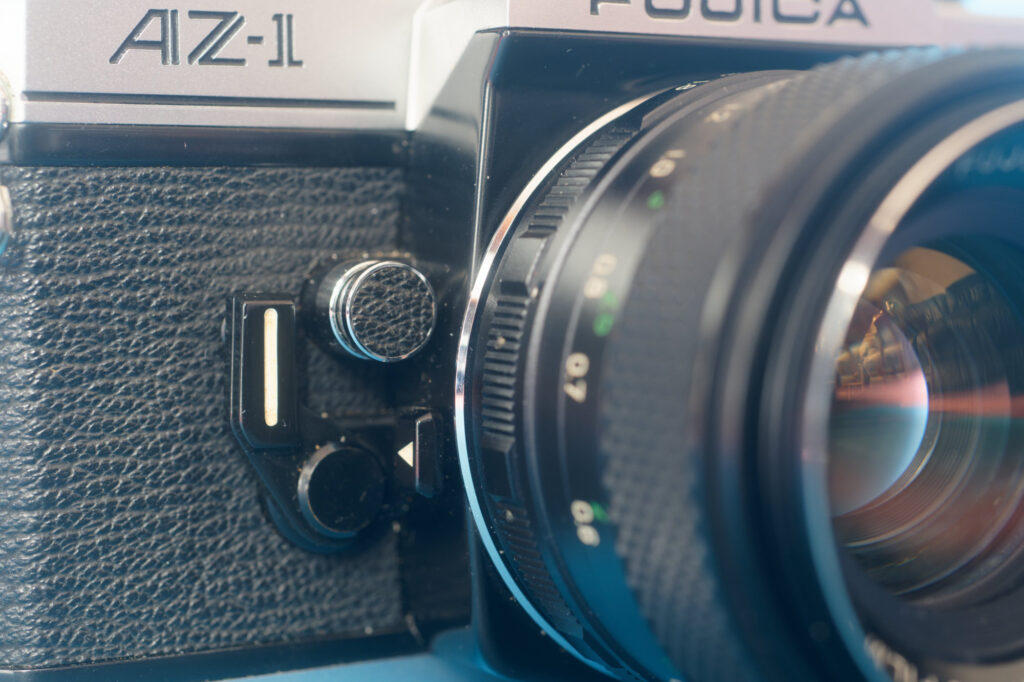
The Fujica screw-mount cameras had this set of controls grouped by the side of the mount, for operation with the right hand.
When the self-timer lever is turned anti-clockwise, it reveals a button that starts the timer and fires the shutter at the end – an arrangement that allows for you to set the timer, but then choose not to use it. When using the self-timer, the camera meters around half way through.
The round button with the leatherette infill stops down the lens for Depth of field preview or metering using stop-down lenses.
The little lozenge with the white triangle infill is the lens release. It retracts a little ‘pip’ on the lens mount. Fujinon lenses have a shallow indent that engages with the pin on the last turn of the screw mount, leaving the lens in perfect register.
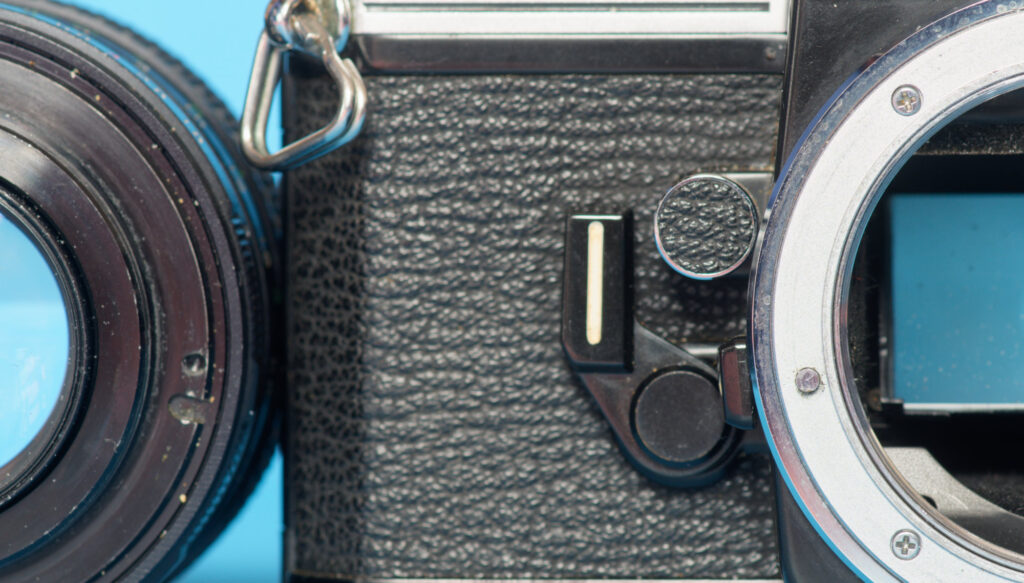
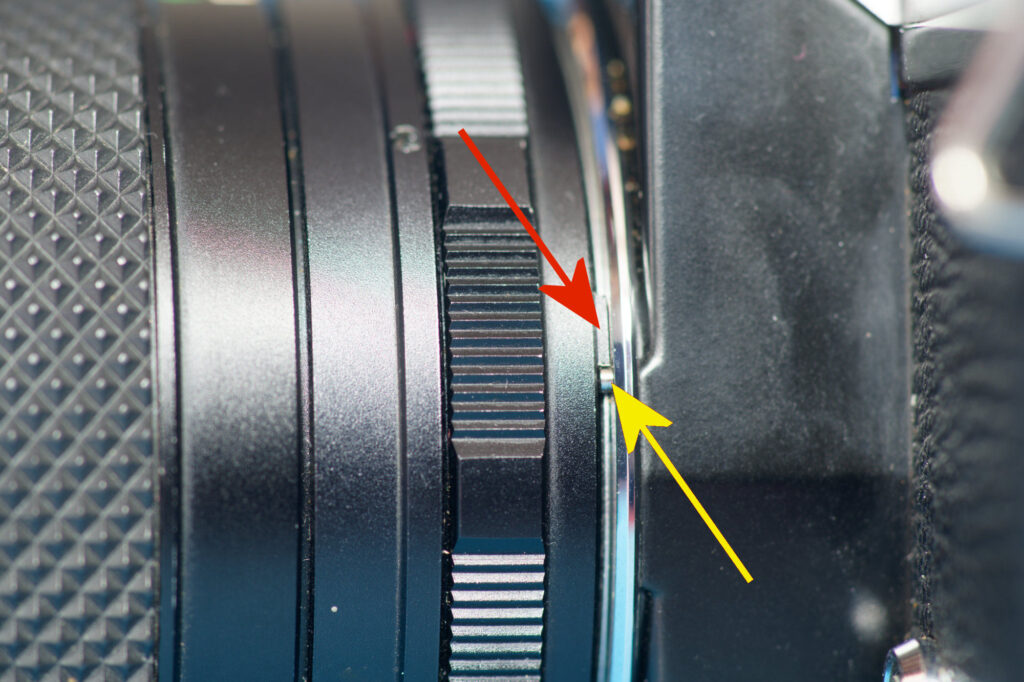
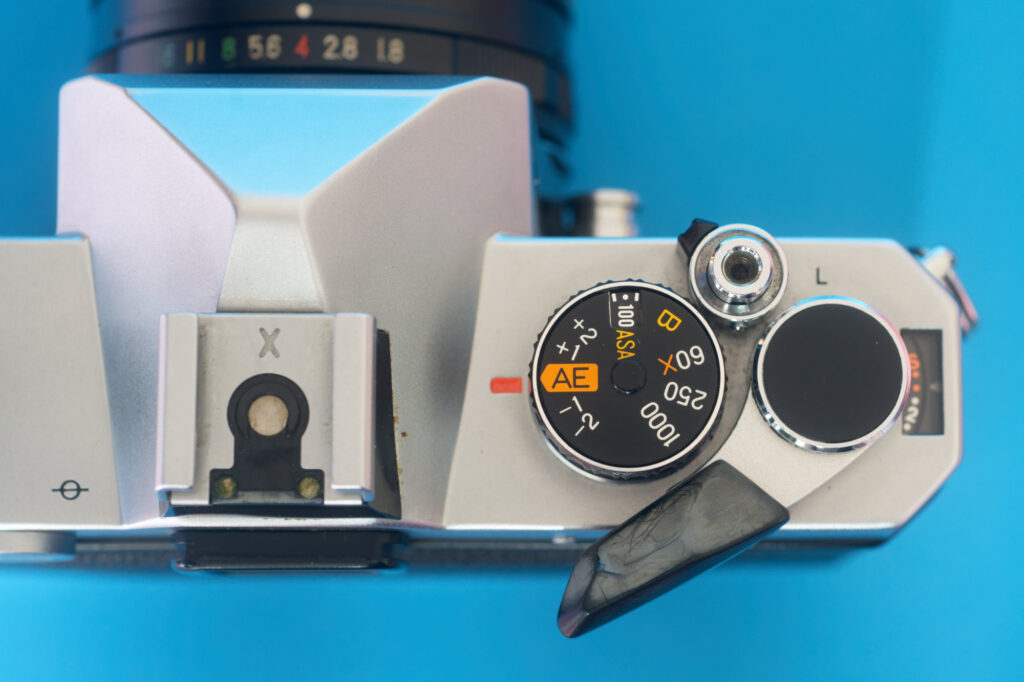
The speed dial features compensation marks. ASA range goes from 25 to 3200 with no apparent restriction on compensation – an improvement on the OM2 which uses a similar system. The lock around the shutter release only locks the top part of the button, so initiating the self-timer fires the shutter even with it set. Although there appear to be two extra contacts in back of the hot shoe, I can find no reference to a dedicated flashgun that used them.
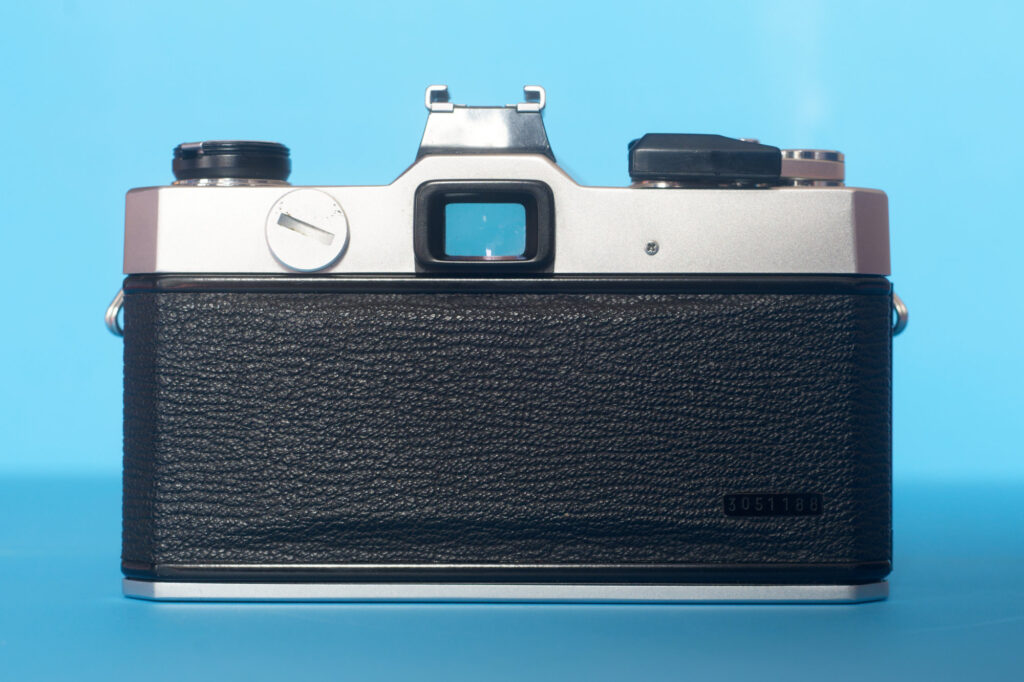
The rear and the base of the camera follow the typical Fujica SLR format. The battery compartment is in the top plate to the left of the viewfinder. The serial number is embossed in the leatherette on the right of the rear door.
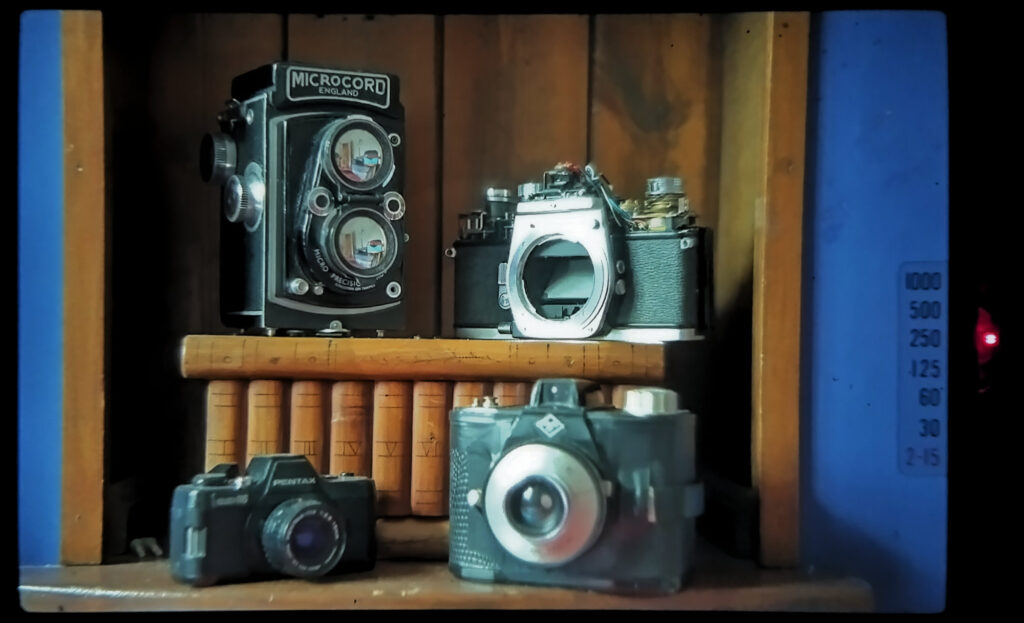
The base has an offset rewind button and tripod socket (the spacing allows film changes on a tripod). New to the Fujica AZ-1 and ST705w were the mechanical and electrical connections for an autowinder.
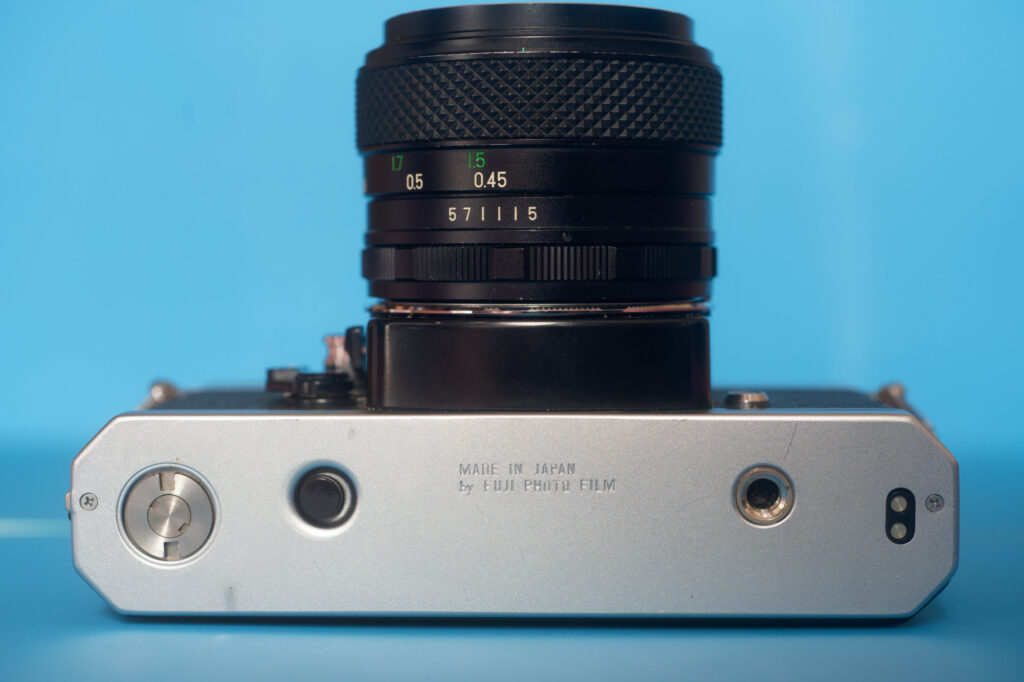
The lens situation
Fujica produced some slightly quirky standard lenses back in the mid 1970s – the budget option was a 55mm f/2.2 lens – faster than the f/2.8 lenses on the cheapest Prakticas, but a bit slower that the f2.0 lenses that Pentax tended towards. They also produced a 50mm f/1.6 – just slightly faster than the competition’s 1.7 and 1.8 lenses. The AZ-1 was offered with a choice of a 50/1.4, a 55/1.8 or (radical at the time) a 43-75 ‘standard’ zoom. From reviews at the time, no-one was too impressed with the performance of the zoom.
The Electron Beam Coating (EBC) on Fujinon lenses is highly renowned so I was looking forward to trying out the (relatively conventional) Fujinon 55 f/1.8 lens that I got with the Fujica AZ-1.
Fujinon 55 f/1.8 lens
The 55 f/1.8 Fujinon is a perfectly decent standard lens (if a little long at 55mm). Notably, it doesn’t claim ‘EBC’ on the ring, although information from elsewhere suggests it does have the coating. Disappointingly, the aperture ring only features click stops at every full stop (and only one between f/1.8 and f/2.8). The focusing ring is also a tiny bit stiffer than I’d like. It is not bad, but it certainly does not have the ‘buttery smooth’ action of an SMC Takumar. This could just be the particular lens I’m using as the AX standard lens I’ve used with the STX-2 is far freer focusing. Other than that it seems fine – and it does allow the camera to meter at full aperture.
Fujinon m42 lenses
Other Fujinon lenses are not so common. The range itself was extensive, taking in 14 different prime focal lengths between 16mm and 1000mm. Like some Takumars, the apertures tend to be colour coded to aid in assessing DoF on the lens focus scale. However, Fujinon lenses are not common. I’m guessing that Fujica resigned themselves to people using non-Fujinon lenses. It is a shame, because Fujica’s solution to using m42 was so elegant and overcame a lot of the issues with the mount.
Note:
- Fujinon m42 lenses don’t have a manual stop-down switch, so if someone is using them on a digital camera they either have to get an adapter that holds the pin in, or they have to be modified to disable the automatic diaphragm.
- Unfortunately, the pip that tells Fujica bodies the setting of the aperture ring sometimes fouls other m42 camera bodies, so may have been filed off some Fujinon lenses by previous owners.
If you are buying Fujinon lenses you need to be aware that they may well have been (as my dear father would have put it) “buggered about with”.
Use with other m42 lenses
Luckily the Fujica AZ-1 plays quite nicely with other m42 lenses. I tried a range of lenses, including Russian 16 and 135 lenses and Pentax 28, 55 and 200mm lenses, and all seemed to give a metering result consistent with the 55/1.8 – albeit with the minor inconvenience of having to stop down the lens manually before exposure.
Variants
There was a slight change to the AZ-1 towards the end of production. This featured black leatherette panels in the sides of the pentaprism housing and the words ‘AUTO ELECTRO’ inscribed above the FUJICA logo (the ST901 also had the same inscription). They also seem to have made black bodied versions in this later style.
In Use
Realistically, the Fujica AZ-1 is going to be used with ‘AE’ selected. With a functional Fujinon lens, the lens will automatically read the aperture set on the lens and will set an appropriate shutter speed between 1/1000 and 1 second (continuously variable), stopping down the lens at exposure.
With other m42 lenses, the idea is that you manually stop down the lens (either with a switch on the lens or by pressing the depth of field preview) and half-press the shutter release – the AZ-1 will then choose an appropriate shutter speed for the light it sees coming through the lens.
Whatever lens is fitted, if it is too bright for your chosen aperture and 1/1000 of a second, the camera will flash the LED next to ‘1000’. If the aperture requires a speed below 1/30 an LED next to the ‘2-15’ LED. An extra LED for 15 and then one for 2-8 (ie ½ to 1/8) would have been nice, but what the AZ-1 offers is reasonably practical.
Although I like trap needle cameras, the implementation in the Fujica AZ-1 does have some quirks. If you half-press the shutter release, and then, not liking the speed shown in the viewfinder, decide to change the aperture, you will not see the effect of the change until you release and then re-half-press the shutter release. This was a change from the ST901, which metered dynamically and which, with its numeric LEDs may well have torn through batteries quicker than Fujica’s customers would have liked (this is a pure supposition on my part, but why else make the change?) In the end, ‘metering only on a half press’ does save batteries, but I’m left thinking that Fujica (who were very capable) really should have been able to come up with a better compromise. As it is, I can forgive the AZ-1 its electronic trap needle simulation, but it doesn’t work as well or intuitively as an analogue equivalent would.
Issues
The articulated plastic tip of the wind-on lever on my Fujica AZ-1 is showing a white bloom. This bloom is not uncommon in plastics of this vintage, but is sometimes a precusor of the plastic becoming brittle and coming apart. There are no signs of weakness in this case, but losing the tip would leave a rather stunted wind-on.
On processing the first film through the camera, I was surprised that the negatives were so dense and that it was difficult to bring detail out in the highlights. I wondered if I might have made an error in processing, so I ran another film through the AZ-1. I also checked the setting the camera was showing in the viewfinder against my Weston Master V – results from both meters were as close as makes no difference.
I had noticed a little more camera shake than I had expected in some of the shots from the first film, so I wondered if the Automatic electronic shutter speeds were matching the meter in the viewfinder. I fitted a preset Takumar 200mm lens (so stop down would not be a factor), metered and took a shot while noting the shutter speed (1/250). I then set the camera to use its 1/250 mechanical speed with the same aperture settings.


In both cases, the shot taken on automatic is on the left – the shot on the right was taken with the same aperture settings but using the indicated manual speed. I think the Fujica AZ-1 is exposing about 3 stops over on auto. As with other very nice cameras of the same vintage that I’ve reviewed here (such as the Minolta XG-9 and Konica FT-1), it is the electronics that break down. Perhaps I need to seek out an ST 705.
Pictures
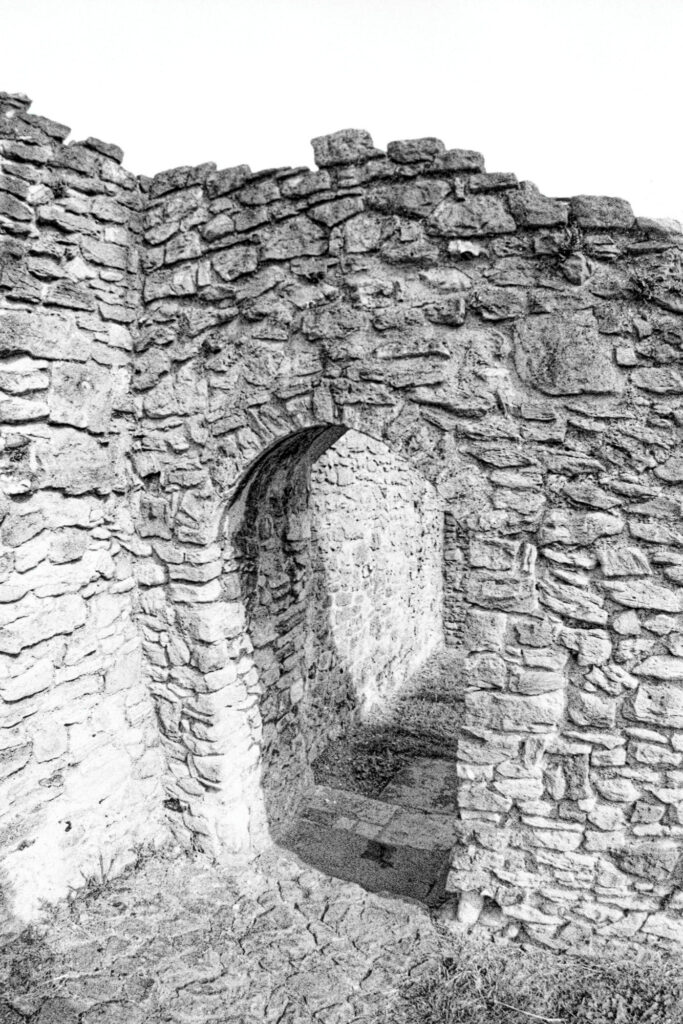
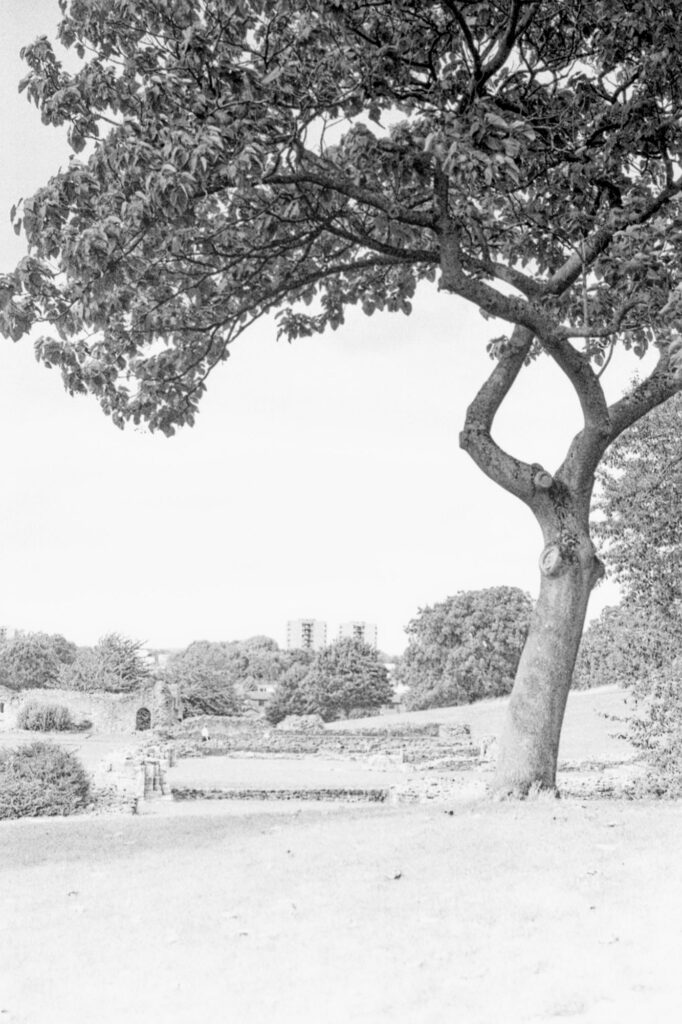
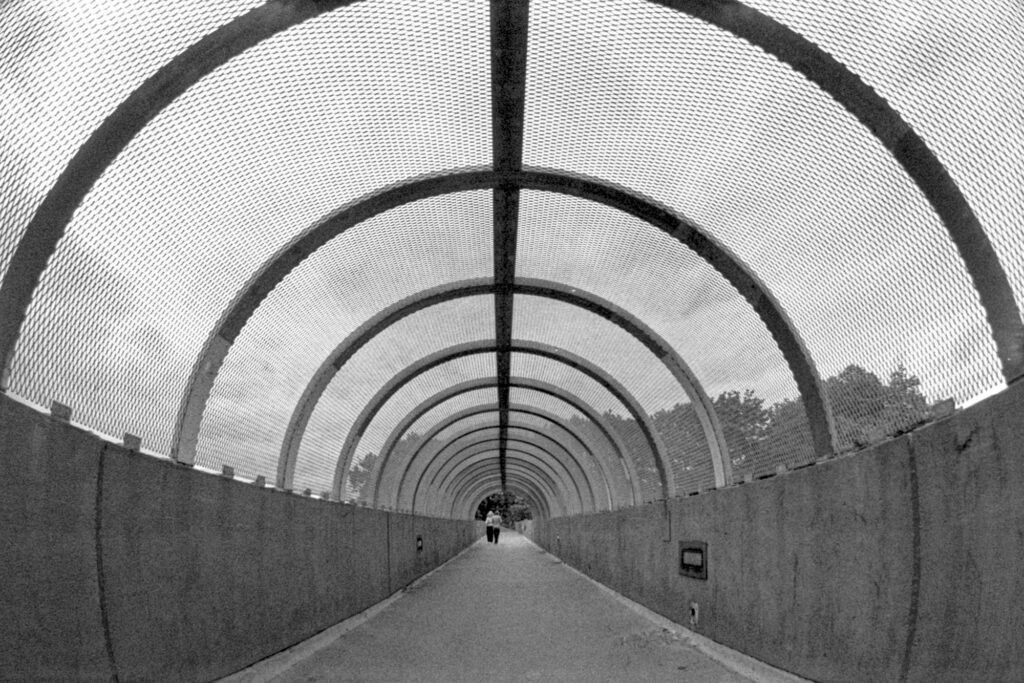
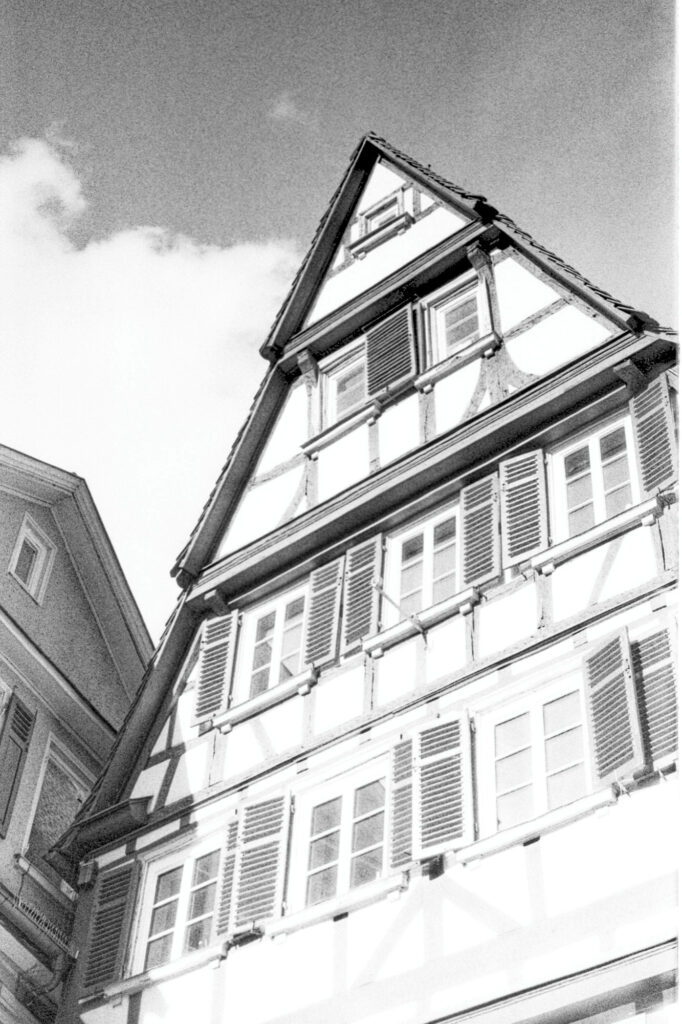
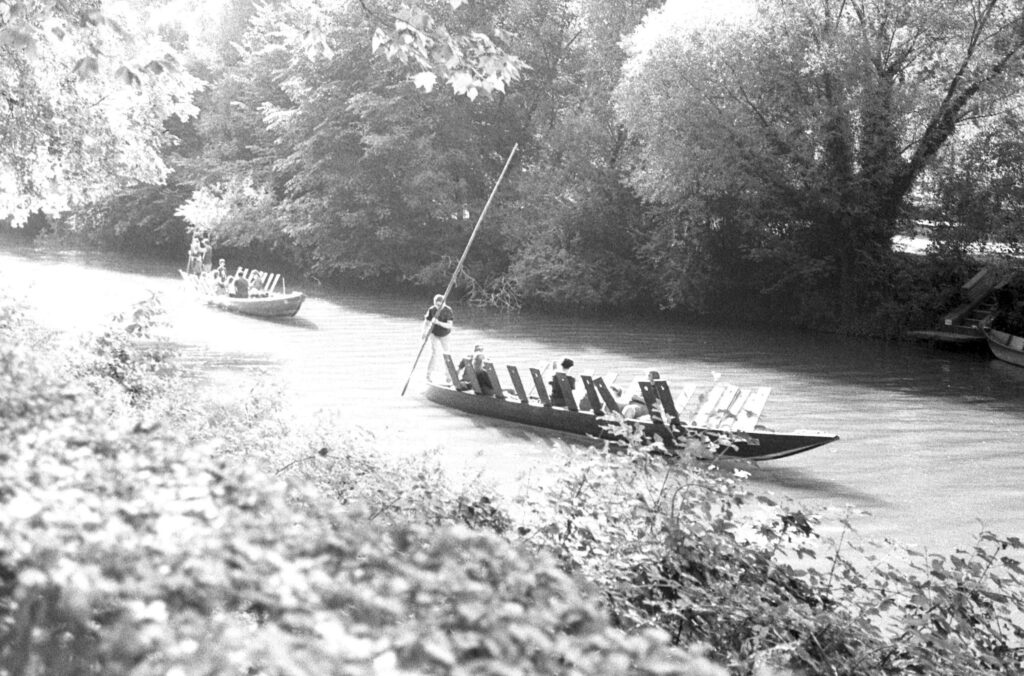
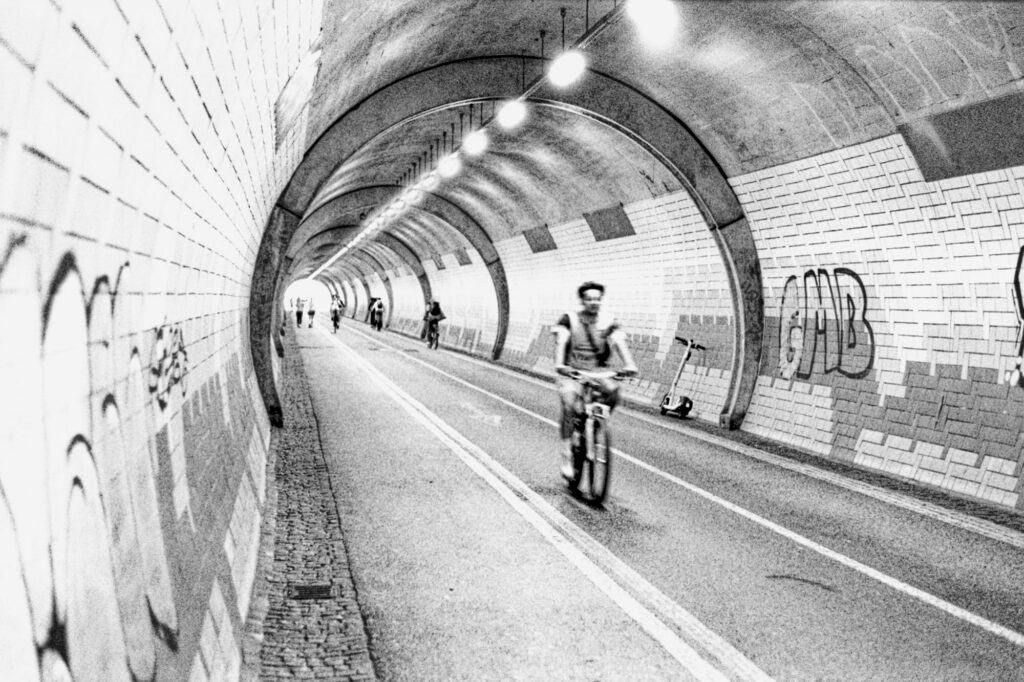
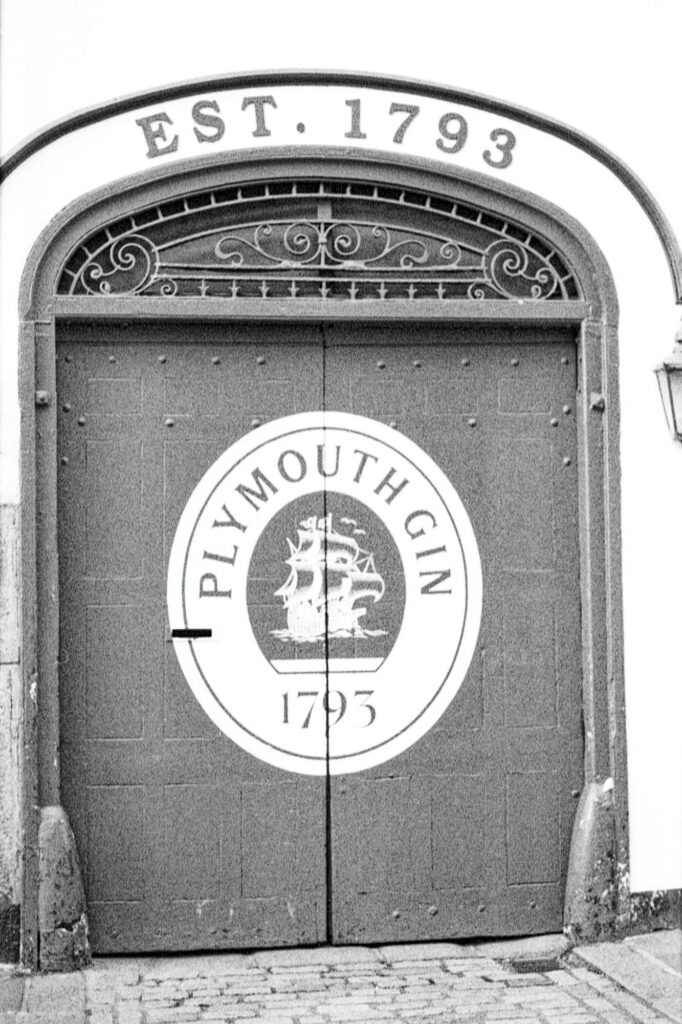
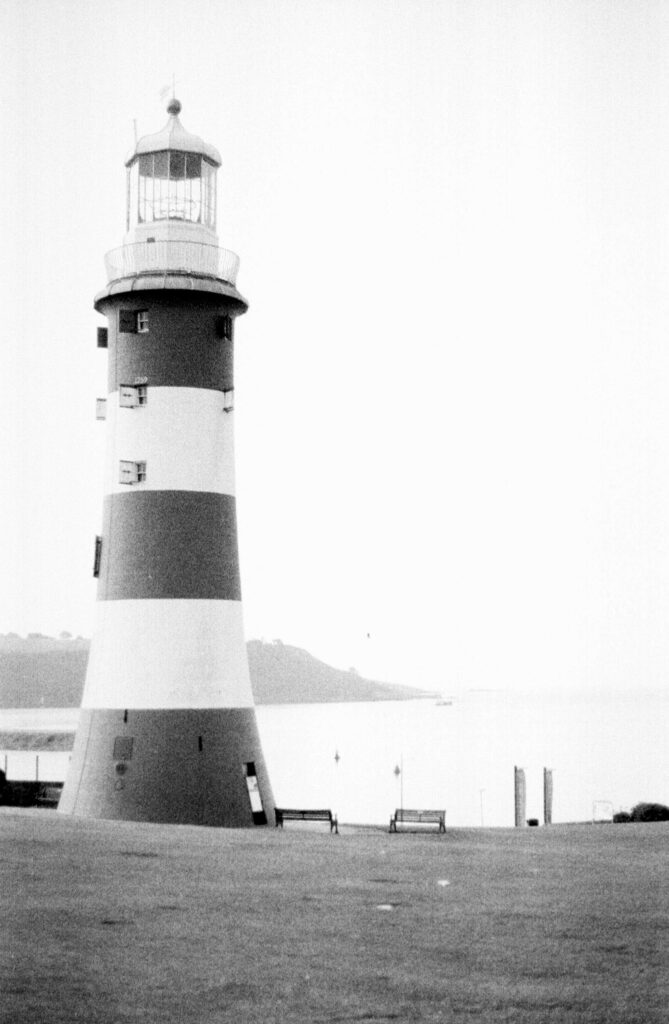
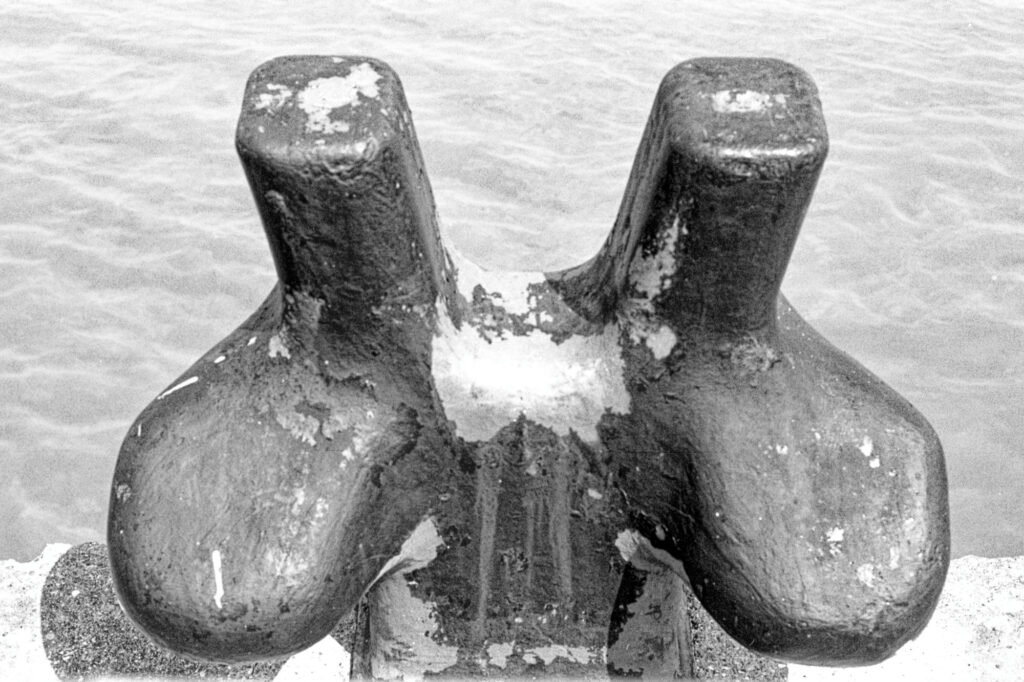
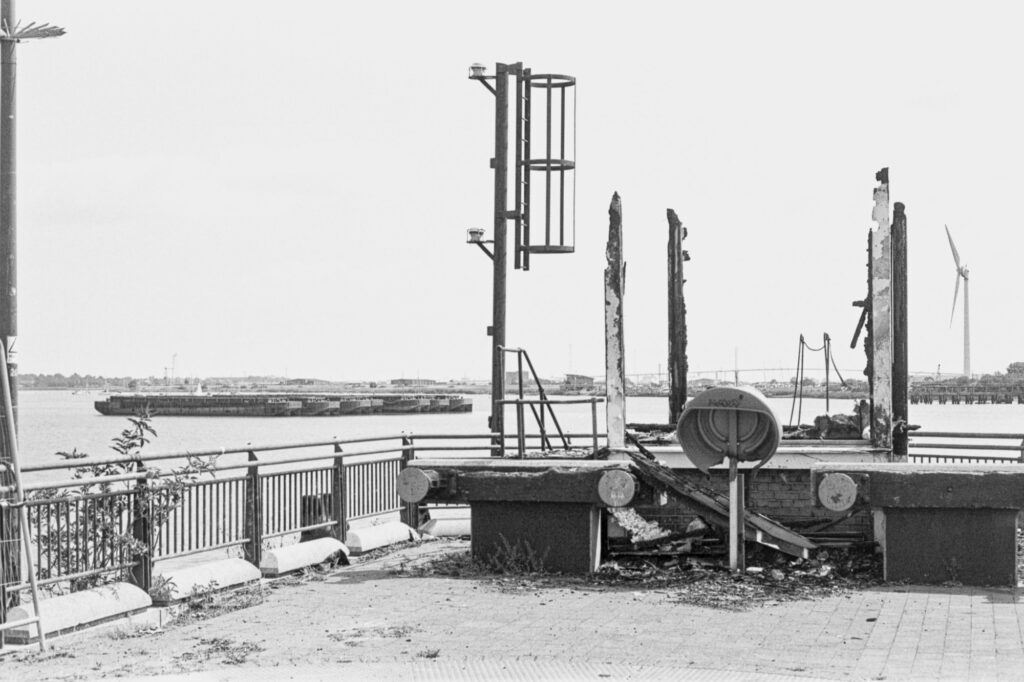
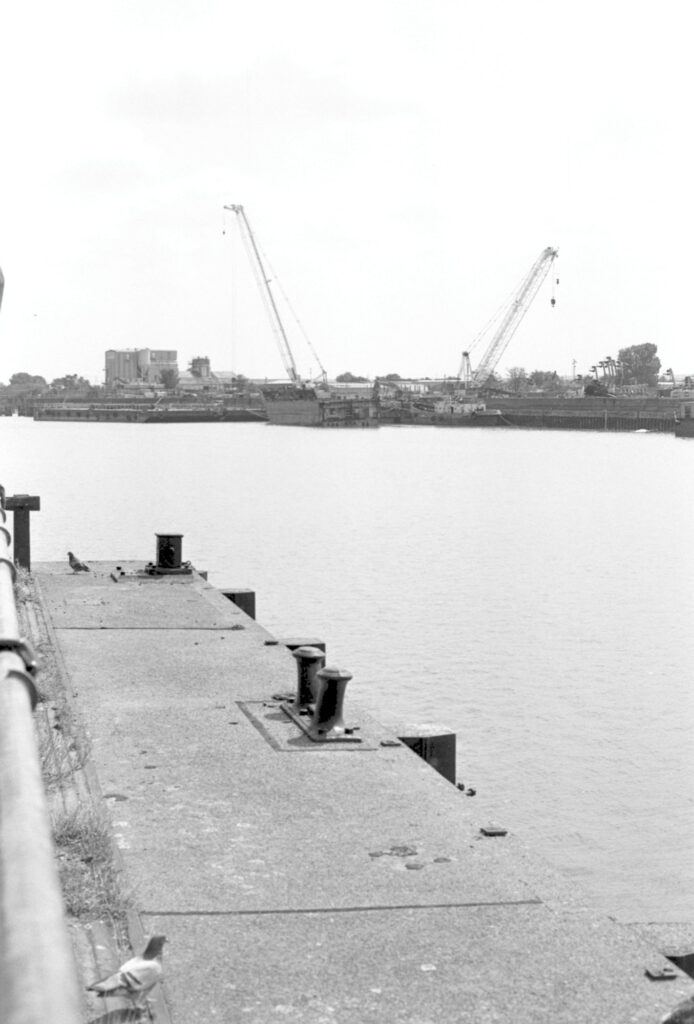
And now
Fujica did alright, despite their bayonet mount AX cameras never really catching on. Of the big companies that dominated the production of film, Kodak, Agfa, and Konica are no longer producing cameras. Fujifilm (as they rebranded to), still make film (not as much as we might like, but still…) – and they have a pair of highly regarded camera lines.
Share this post:
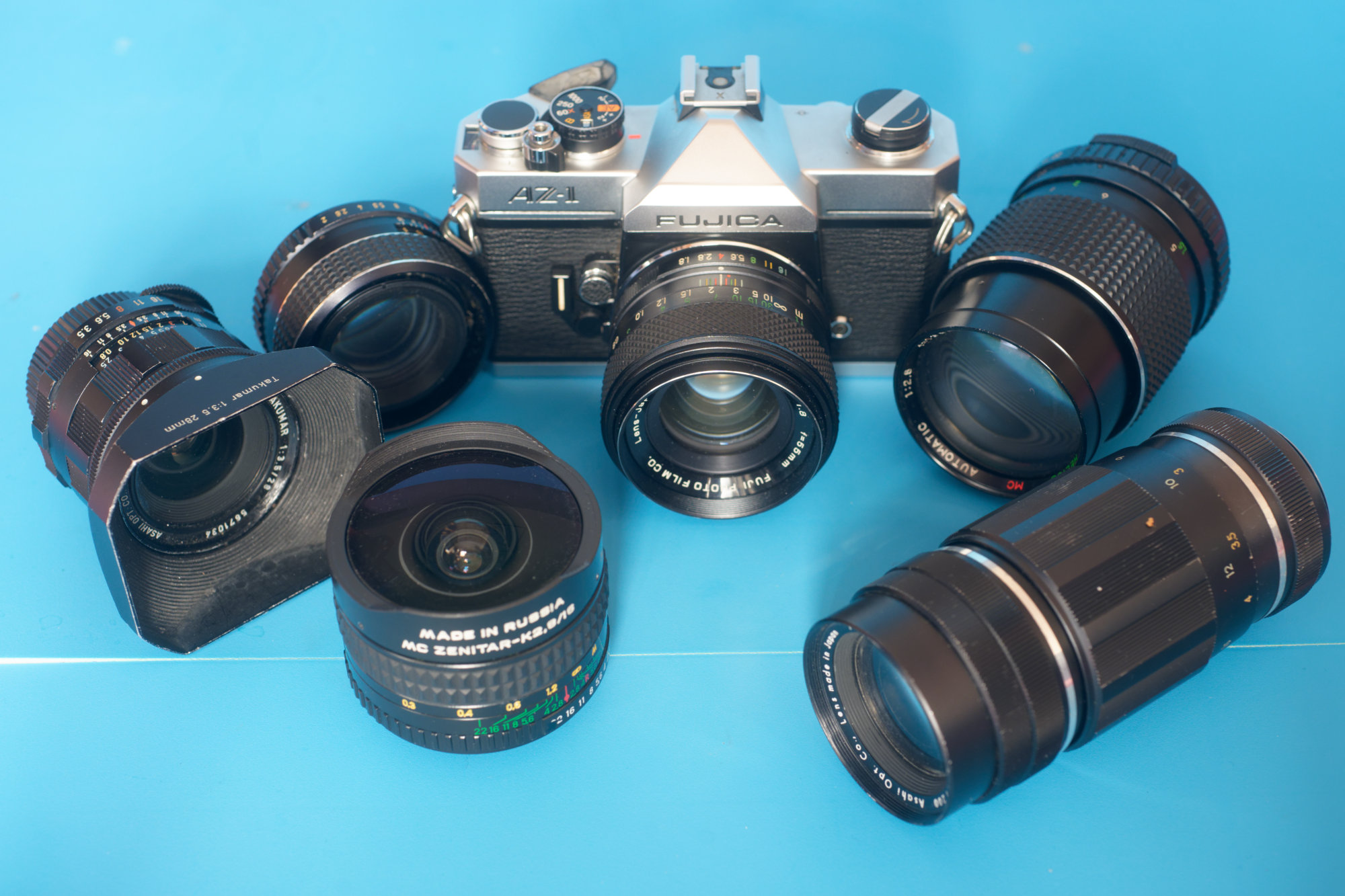
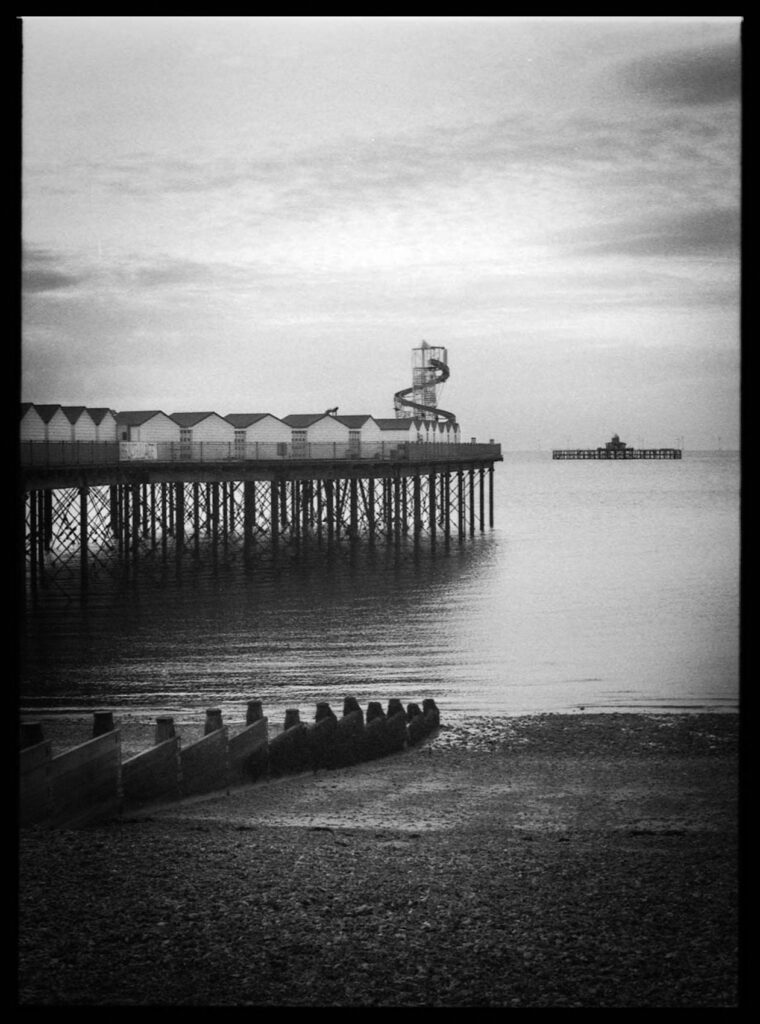
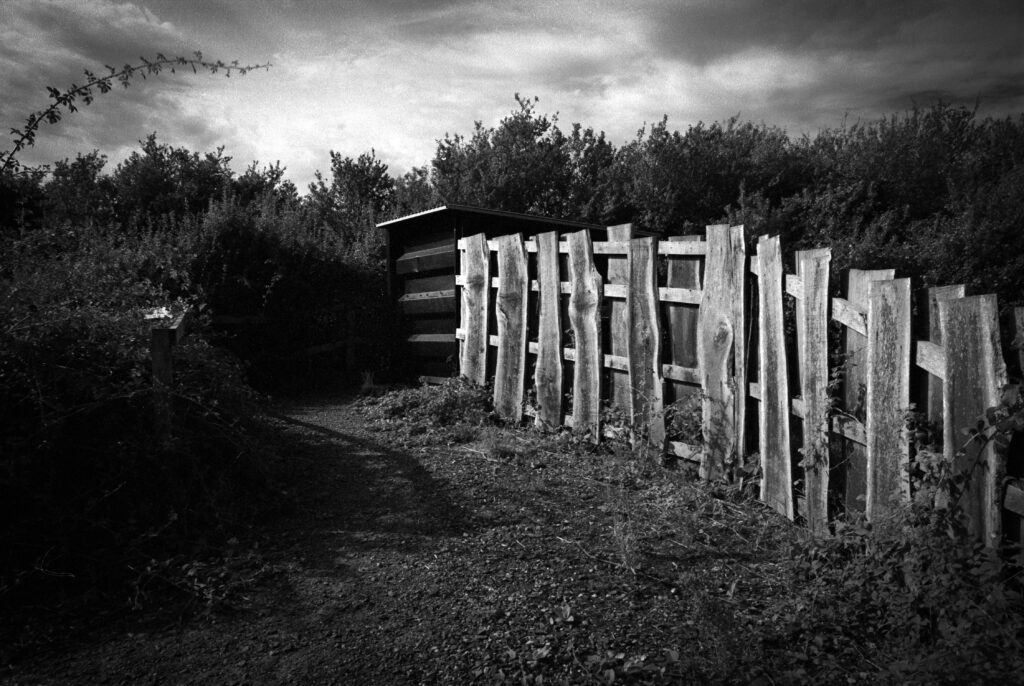
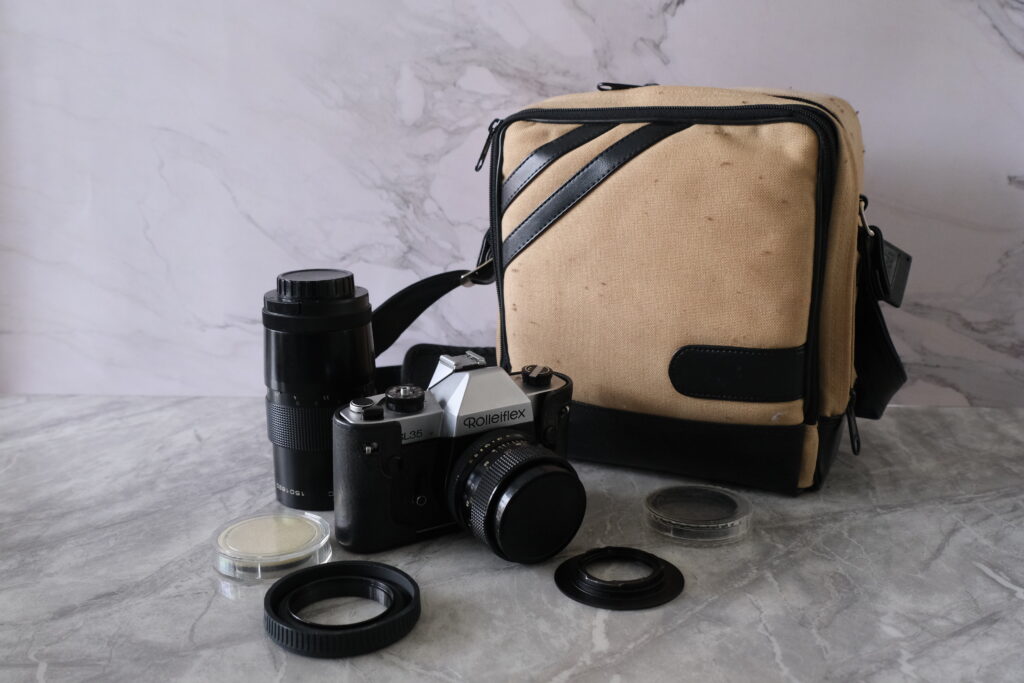
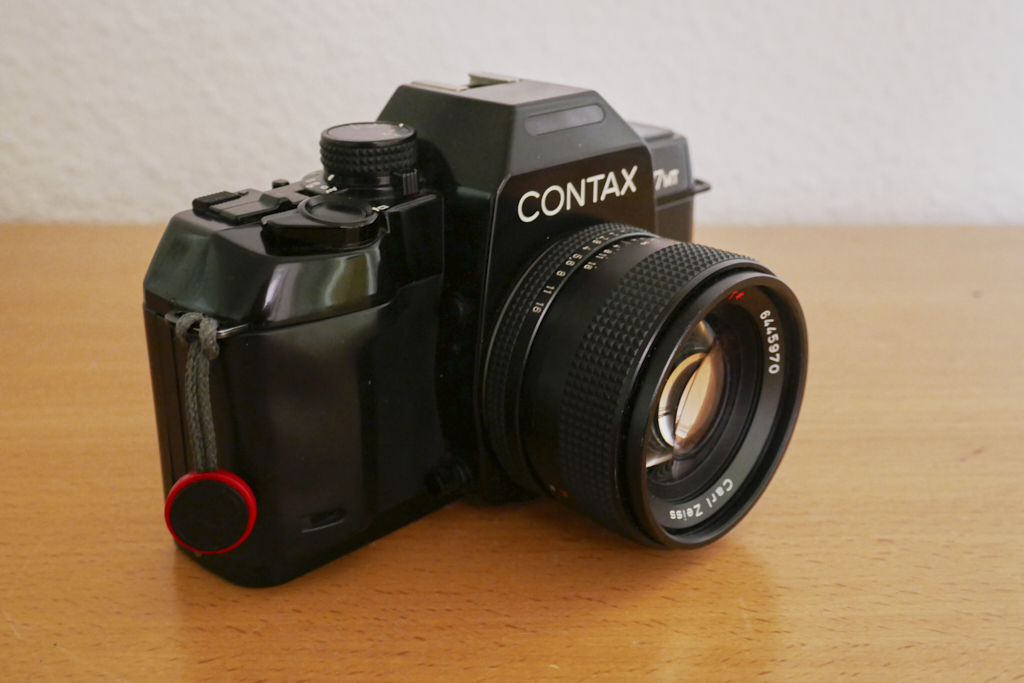
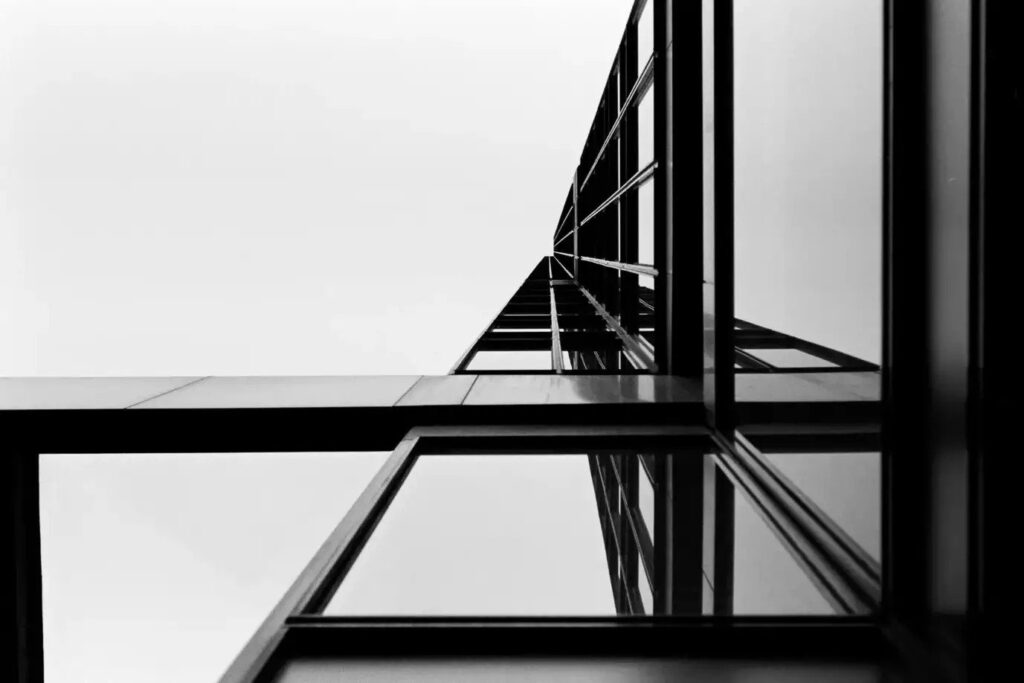
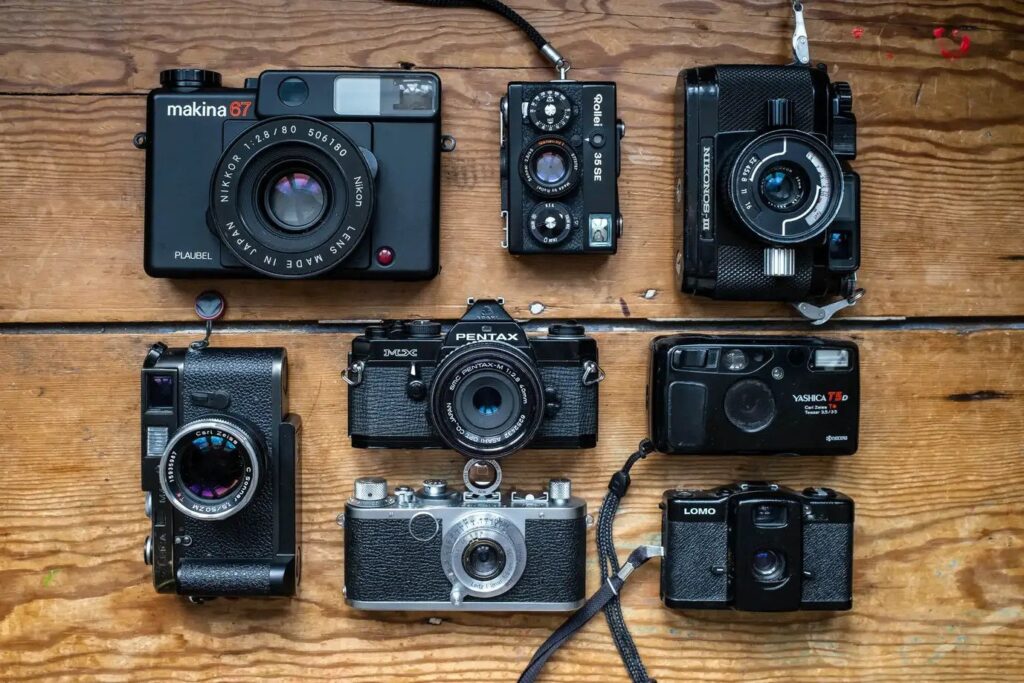
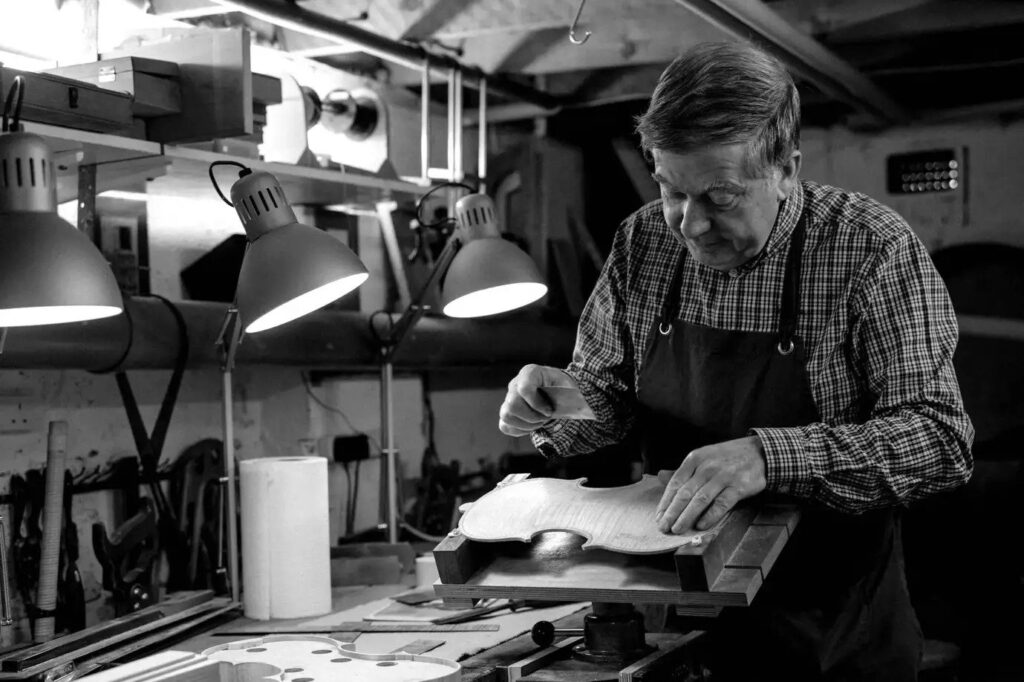
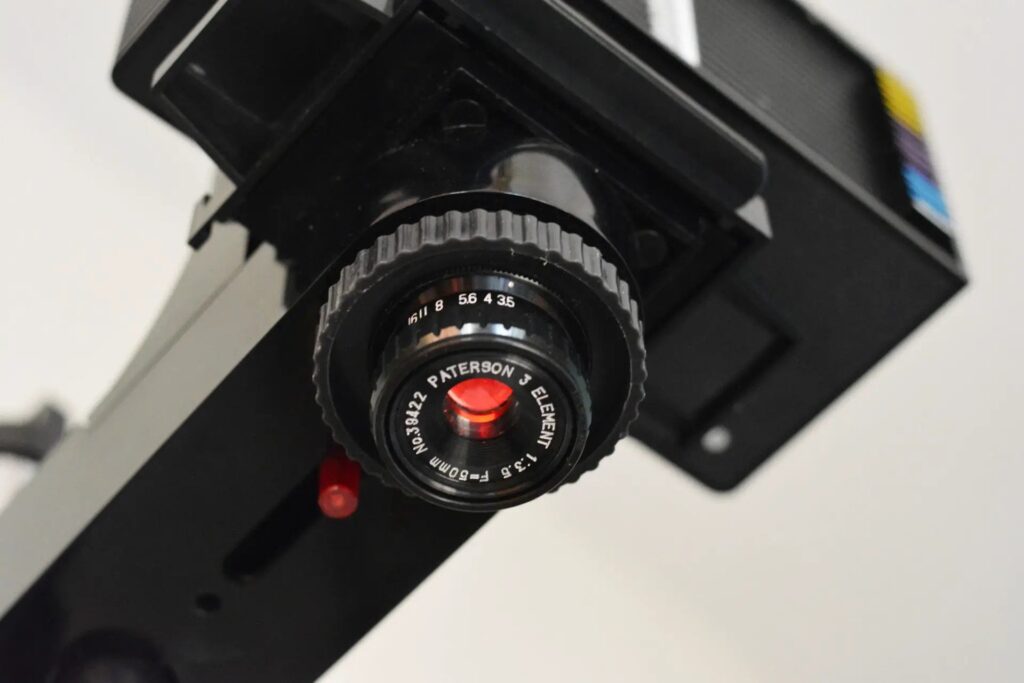
Comments
Russ Rosener on Fujica AZ-1 Review – A Swansong for M42?
Comment posted: 13/10/2025
Thanks for the deep dive into these cameras which were the last of the new M42 mount family. Quite overlooked for no good reason.
Comment posted: 13/10/2025
Walter Reumkens on Fujica AZ-1 Review – A Swansong for M42?
Comment posted: 13/10/2025
https://cjo.info/classic-analogue-cameras/fujica-st901/
Nevertheless, as a GAS victim, I now own the ST 705 + ST 605N with various lenses, including the zoom that was offered with the AZ-1. I am very satisfied, without automatic, without LED/LCD. It was too early for the automatic at the time.
Thanks for the article.
Ibraar Hussain on Fujica AZ-1 Review – A Swansong for M42?
Comment posted: 14/10/2025
Murmur on Fujica AZ-1 Review – A Swansong for M42?
Comment posted: 20/10/2025
I will go searching for the 55mm...